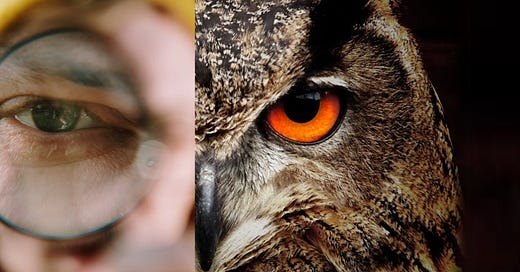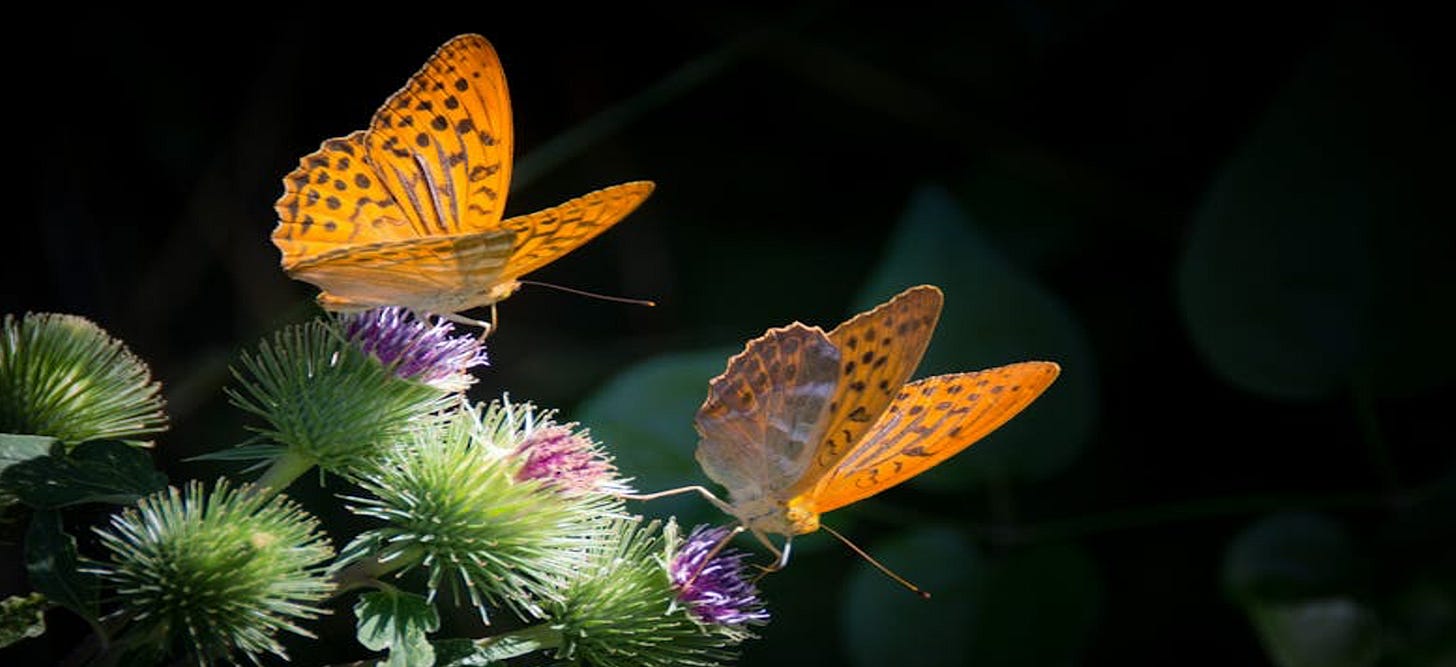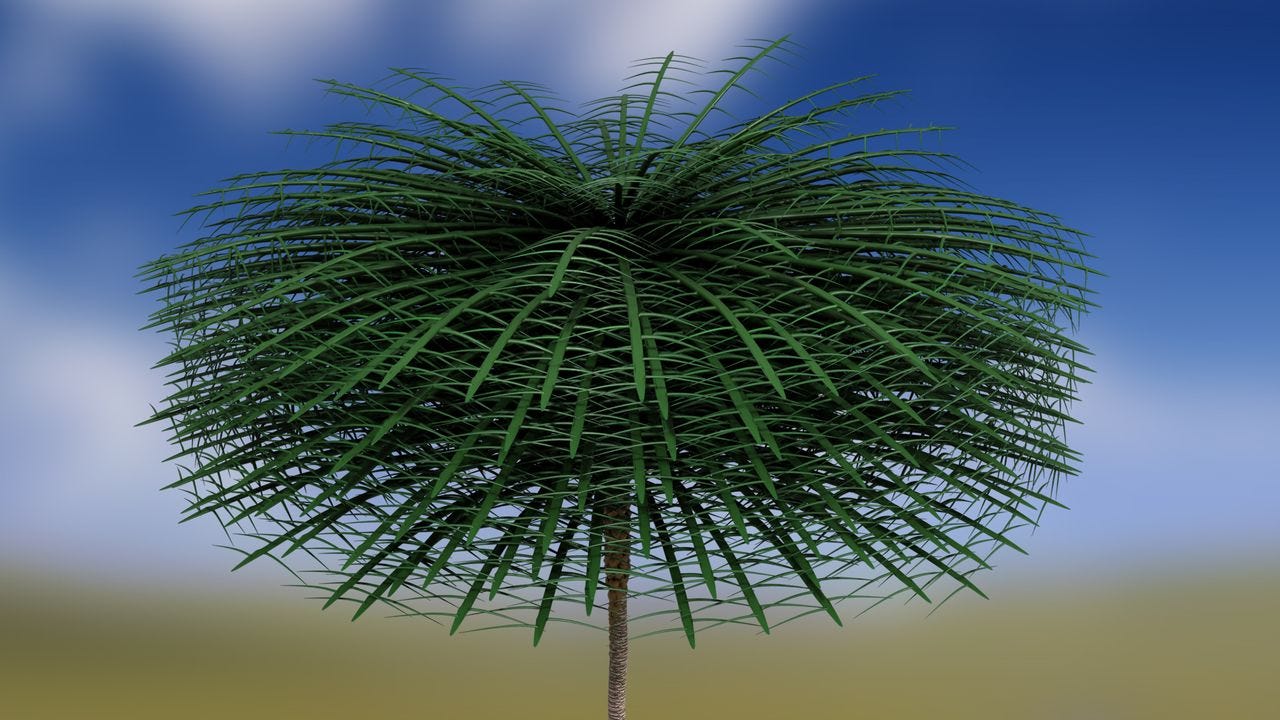🍄 Imageomics: New Species Discovery
There’s a great species revival sparked by rekindled interests in biodiversity but despite recovery and discovery, there’s still an identity crisis.
🌏 Dedicated to this blue dot we call home. Earth Day April 22, 2024.
Exploring every rabbit hole there is. For more wanderings, become an Alice in Futureland subscriber—it's free.
🍄 AudioDose Alice on Sonic Mushrooms: listen to Earthcore
🎧 Alice podcasts
📘 Alice books
Hello, we’re Alice and we are always in a state of wander. From de-extinction science and the new field of “imageomics”, explorers are identifying new species at a rate that would have amazed Charles Darwin. A boom in the discovery of species—and others making a comeback—leads conservationists back down the garden path. These scientific collecting expeditions come at a time marked by the significant global impact that humans are having on the planet’s ecosystems. And while experts equipped with techy new toolkits are able to identify species in novel new ways, recognition extends to Indigenous communities who power up—rather than overpower and objectify—the nature trail with their knowledge and knowhow.
The species network
Nearly 1,000 new species were discovered last year by scientists at London’s Natural History Museum, and the California Academy of Sciences—including a legless lizard and previously unidentified dinosaur. And a fresh wave of wonders was found at sea.
Although oceanographer Sylvia Earle once pointed out that humans, “know the surface of Mars better than our ocean floors,” many new discoveries recently rolled in. A new species of 65-million-year-old fossil shark was found in Alabama and four black eggs surfaced from the dark heart of the ocean—cocoons of the deepest flatworms ever found.
But so many more slip through the net. Around 80% of a possible 8.7 million species on Earth, in fact. ‘We are currently thought to only know about 1.6 million species, with around 18,000 previously unidentified ones being added to our catalogue of life annually,’ reports The Royal Society, the world’s oldest scientific academy.
“It seems odd to think that we don’t know all the species on our planet,” wrote Alexander Rose, Emeritus Executive Director of The Long Now Foundation, a non-profit that fosters long-term thinking. “If we were to discover life on Saturn’s moon Titan for instance, you would think that the first thing we would do would be to catalogue it. Yet we are still discovering new species, genus and even families on our planet at a regular rate, even as the number is declining at an even more alarming rate.”
Species upload
Indeed, last year’s discoveries tied in with the 50th anniversary of the US Endangered Species Act, which offers protections for threatened plants and animals and has helped save hundreds of species.
The Long Now Foundation once launched a spin-off project to catalogue all things great and small called All Species. Similar projects bloom today, such as Map of Life and The International Barcode of Life, whose debut project, BARCODE 500K, established the effectiveness of DNA barcodes in providing quick and accurate specimen identification. E.O. Wilson’s Encylopedia of Life, digitally details everything known about individual species from its genome and proteome to its distribution, habitat, and ecological relationships. And The Census of Marine Life a decade-long, $650 million, global effort to assess the diversity (how many different kinds), distribution (where they live), and abundance (how many) of marine life.
Butterfly-like hunters
Camera traps, alongside satellites, drones and even vacation photos and safari snaps are helping experts piece together the puzzling world of species-spotting. ‘Imageomics’ is a new interdisciplinary scientific field focused on using machine learning tools to understand the biology of organisms, particularly biological traits, from images. “The field is new—the Imageomics Institute was just founded in 2021 —but big things are happening,” said Tanya Berger-Wolf, director of the Imageomics Institute at Ohio State, at the annual meeting of the American Association for the Advancement of Science.
New research on butterflies is one example of the advances that imageomics is making. Berger-Wolf and colleagues are studying mimics – butterfly species whose appearance is similar to a different species unsavory to predators. “We can’t tell them apart because these butterflies didn’t evolve these traits for our benefit. They evolved to signal to their own species and to their predators,” she said. “The signal is there – we just can’t see it. Machine learning can allow us to learn what those differences are. But more than that, we can use the imageomics approach to change the images of the butterflies to see how extensive the mimics’ differences must be to fool birds. Researchers are planning to print realistic images of the butterflies with subtle differences to see which ones real birds respond to.”
Beak-a-boo, squeak-a-boo
“Every single species does matter,” conservationist Christina Biggs tells Scientific American. She has been curating a list of 25 “most wanted” species for charity Re:wild since 2017. Re:wild was founded by a group of scientists together with Leonardo DiCaprio, bringing together Indigenous peoples, local communities, influential leaders, nongovernmental organizations, governments, companies, and the public to protect and rewild at the scale and speed necessary.
Species are vanishing 1,000 times faster than the natural background rate of extinction – a pace that surpasses even the aftermath of the comet that led to the demise of the dinosaurs.
The human toll
“As a species, we are well placed to survive the mass-extinction event we are currently generating,” writes palaeobiologist Thomas Halliday in the Sunday Times bestselling Otherlands: A World in the Making [Penguin, 2022]. “With our technology, from clothing to dykes, air-conditioning, and desalinators, we have consistently modified our environments to survive where otherwise we would not. But the ecosystems that have been built since the last mass extinction 66 million years ago are under severe stress. By destroying communities and changing the chemistry of the world, we are tugging at the strands of the spider’s web once more, and several strands have already broken. If enough snap, the consequences for the way we interact with the world could become a biological and social catastrophe unlike any ever faced. This might seem at first glance to be overwhelming, paralysing. But the very fact we can reflect on the state of our environment at all, that we have the analytical ability to look at the past and find analogues for the present, is the reason that we can be positive.”
On the brink
Botanist Denise Molmou of the National Herbarium of Guinea in Conakry, discovered a new plant species in 2018, that seemed to inhabit a single waterfall in Guinea. Prior to her team publishing their findings in the Kew Bulletin last year, Martin Cheek, a botanist at the Royal Botanic Gardens in Kew, United Kingdom, located the waterfall on Google Earth. A reservoir, created by a hydroelectric dam downriver, had flooded the waterfall, surely drowning any plants there. “Had we not got in there, and Denise had not gotten that specimen, we would not know that that species existed,” Cheek told Undark. “I felt sick, I felt, you know, it’s hopeless, like what’s the point?” Even if the team had known at the point of discovery that the dam was going to wipe it out, Cheek said, “it’d be quite difficult to do anything about it. It’s critical to identify un-described species and the threats they face, because if experts and policymakers don’t know an endangered species exists, they can’t take action to preserve it.”
The extinction files
While discoveries and recoveries are celebrated, species losses are always looming. “There is evidence that some species are becoming extinct before they are even discovered, which could mean estimates of global extinction rates are likely to be too low,” reports The Royal Society. Scientists call these silent extinctions ‘dark extinction.’
“I think we want to have a full assessment of humans’ impact on nature,” Ryan Chisholm, theoretical ecologist at the National University of Singapore, told Undark. “And to do that, we need to take account of these dark extinctions as well as the extinctions that we know about.”
“Species are already being lost at an unprecedented rate due to human activities that are causing land and coastal use change, pollution, over-exploitation, introduction of foreign species and climate change,” continues The Royal Society. In 2019, the Intergovernmental Science-Policy Platform on Biodiversity and Ecosystem Services warned that about 1 million species of plants and animals are now threatened with extinction.
Fresh prints
Let’s focus on a fairy tale ending. While filming Pole to Pole with Will Smith for Disney Plus, Professor Bryan Fry of the University of Queensland discovered a whole new species of snake. The combination of the size of the find, celebrity link, and environmental significance makes it “the biggest achievement of my career,” Fry—who has previously found fish with opiates for venom— tells IFLScience. “The only way it could be bigger is if I [scientifically] described a xenomorph that had just jumped out of Taylor Swift’s chest.”
As the scientific team leader for the Amazonian part of the National Geographic documentary, Fry was in the process of the most extensive anaconda sampling ever conducted, when his team – and Will Smith – noticed the green anacondas of Ecuador are larger than those in Brazil – although they looked almost identical. On taking genetic samples however, they found there is a 5.5 percent difference in DNA between the two. “To put it in perspective, humans differ from chimpanzees by only about 2 percent,” Fry noted.
While the existing ‘southern green anaconda’ is widespread, the ‘new’, larger ‘northern green anaconda’ is in danger, affected by oil drilling in the Amazon, widespread logging and a devastating drought. Fry also intends to see if oil pollution is affecting male fertility.
Jurassic reality?
On Youtube you can listen to the MP3 audio recording of the last Kaua’i ‘ō‘ō bird mating call. It’s a static, one-sided communication; a message transmitted to a mate that no longer exists. Danish artist Jakob Kudsk Steensen used virtual reality (VR) technologies in his installation RE-ANIMATED (2018-19), which was on view in the Future Generation Art Prize’s exhibition in Venice, to brings the Kaua’i ‘ō’ō bird back to imaginary life. The self-called “digital gardener” recreates lost landscapes to raise awareness about climate change. “The technologies allowed me to show things to you—for example, how past landscapes can change overtime, how you can look from the scale of a beetle, how you can change your perspective,” Steensen tells Artnet.
The art gave Sarah Bezan, postdoctoral research associate at the University of York, food for thought. She used speculative narratives and artistic representations of genetic rescue for her research to answer: why should we bring back extinct species in virtual reality? “The prospect of bringing back extinct species through de-extinction science (through the means of gene editing, reproductive cloning technologies, and back breeding) invites us to imagine what these revived species and ecological habitats might look like, and how they might function. Since de-extinction is a prospective conservational programme (comprised of a set of tools still in development), I argue that we are at a critical juncture in time in which authors and artists are creating the cultural space necessary to explore the environmental risks and potentials of de-extinction, along with the shifting emotional contours of species loss and revival in the twenty-first century.”
Catching nature’s vibe
Like a computer, nature has a memory that can be stored and accessed. For example, stem cells can memorize the form and function of all cells, allowing blood cells to become muscle cells and so on. In fact, memory may be an inherent property of all matter and space. The late physicist John Archibald Wheeler mentioned to us during an interview in 2002 that he kept on his windowsill a rock from the garden of the Platonic Academy, founded by Plato in about 428 BC in ancient Athens, and that it was his wish that one day there could be a mechanism that could unlock its sounds so that he could hear the discussions between Aristotle and Plato. Perhaps, if we are “in tune” with the Earth, we, as a species, can resonate with nature’s collective —ALICE, from “Tuning into Frequency: The invisible force that heals us and the planet.”
What else we are wandering…
🌳 Hidden life of trees
The discovery of five tree fossils buried alive by an earthquake 350 million years ago, was published in the journal Current Biology. Found in a quarry in the Canadian province of New Brunswick, the authors said these new and unusual fossil trees not only bear a surprising shape reminiscent of a Dr. Seuss illustration, they reveal clues about a period of life on Earth of which we know little. “Finding complete fossil trees is rare and much less common than finding a complete dinosaur,” claims Peter Wilf, a professor of geosciences and paleobotanist at Pennsylvania State University.
🌺 Flower crowning glory
From Venus’s flower basket to Dorothy’s rope, the naming of species is a field in itself. Charlotte Taylor, one of 60 taxonomists at the Missouri Botanical Garden, has named 500 new plant species, more than any other living female taxonomist. She was unaware of her star status until contacted by researchers from Royal Botanic Gardens, Kew and the University of Cambridge. Their 2023 study “Acknowledging female role models in botanical and mycological taxonomy” documented the contributions of women scientists across decades — and found that Taylor’s 500 new plant species made her the third-most prolific female botanist in history. “The general question is, ‘What is all this life around us?’” explained Taylor. “This is imposing a scientific framework on stuff that scientists can use. You have to understand what the plant is doing, and who the plant is, before you can name it.”
🔍 Naming and shaming
Gender bias has been found in the names given to new species. Researchers at the University of Otago in New Zealand set their sights on eight prominent journals, searching for newly named species, over the years 2000 to 2020. Of the 596 newly named species that had been named to honor an eminent scientist, just 19% were for women. The ratio persisted over the past twenty years, and they found that for scientists who have been honored twice with a naming, 89% were male.
🪴Plants for women!
Calls for less bias in botany too. A social media conversation about plants named for people spiralled into a study by a global network of scientists this year. A question about how many and which plant genera were named for women grew into a scientific dataset. The group have identified more than 700 plant genera named for women.
🦖Dinosaur views
Not just prejudice in the plant world. After 200 years, scientists are calling for overhaul of antiquated system of naming dinosaurs. Palaeontologists want more rigorous guidelines for naming species, reports Nature, along with action to address problematic historical practices.
Emma Dunne, a palaeobiologist at Germany’s Friedrich-Alexander University and her colleagues analyzed the names of all of the dinosaur fossils from the Mesozoic Era (251.9 million to 66 million years ago) that have been described, around 1,500 in total. They found 89 potentially offensive names (less than 3% of the dinosaurs they looked at) which they describe as those “emanating racism, sexism, named under (neo)colonial contexts or after controversial figures”.
Some of the names the team identified derive from the colonial names for lands where species have been discovered and Indigenous-language names of places or researchers are often not used or are mistranslated, the authors say.
Craving more?
Alice newsletters:
🍄 Trees Talking: Globally, there are estimated 3.04 trillion trees—roughly 422 trees for every person on earth. Trees talk, signal and sense. Can we listen?
🍄 Call of the Wild: An estimated 8.7 million species of plants and animals co-exist with humans on the planet. If survival is about fitting in with the rest of life, does nature need a digital intervention?
📘 Alice in Futureland books
🎧 Alice in Futureland podcasts
Thanks for tuning in.
For more wanderings, become an Alice in Futureland subscriber—it's free.
Invite your friends to this mad tea party and let's see how many things we can learn before breakfast.
©2024 Alice in Futureland








